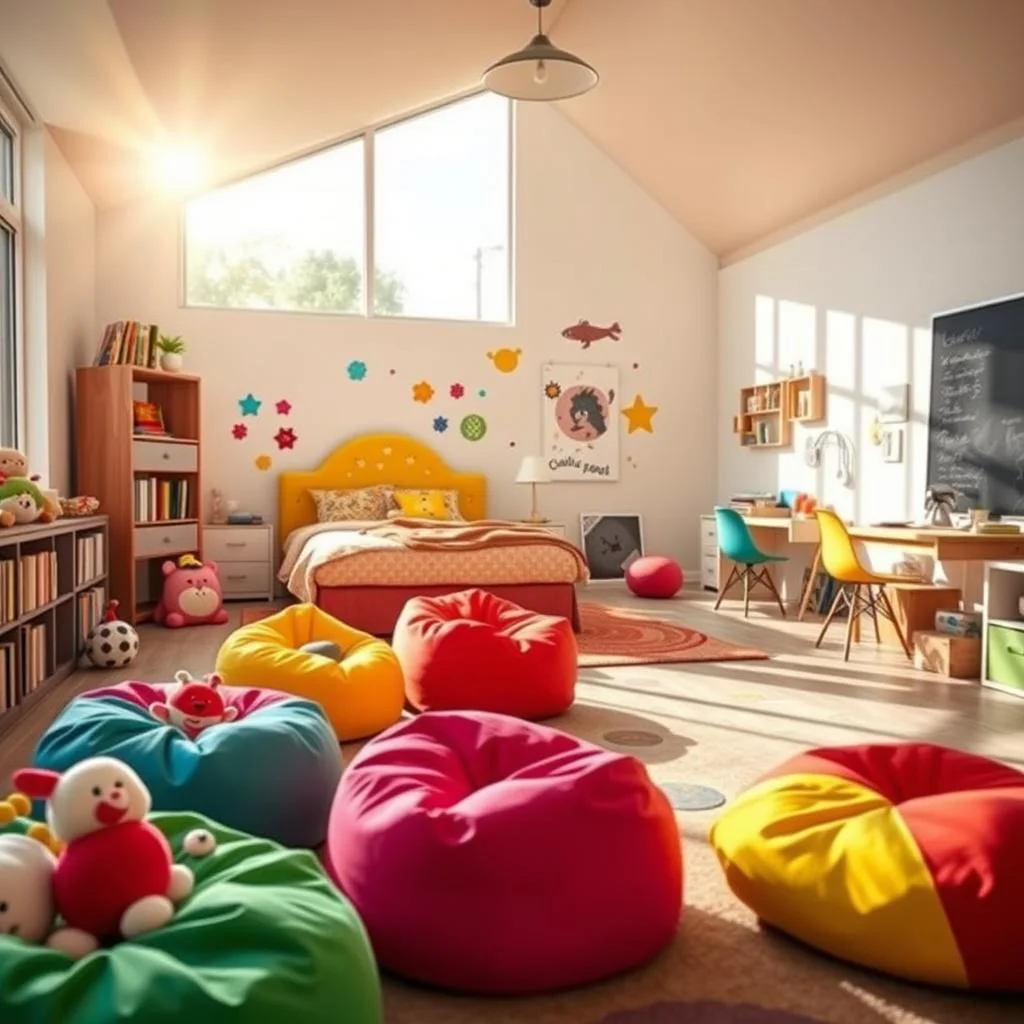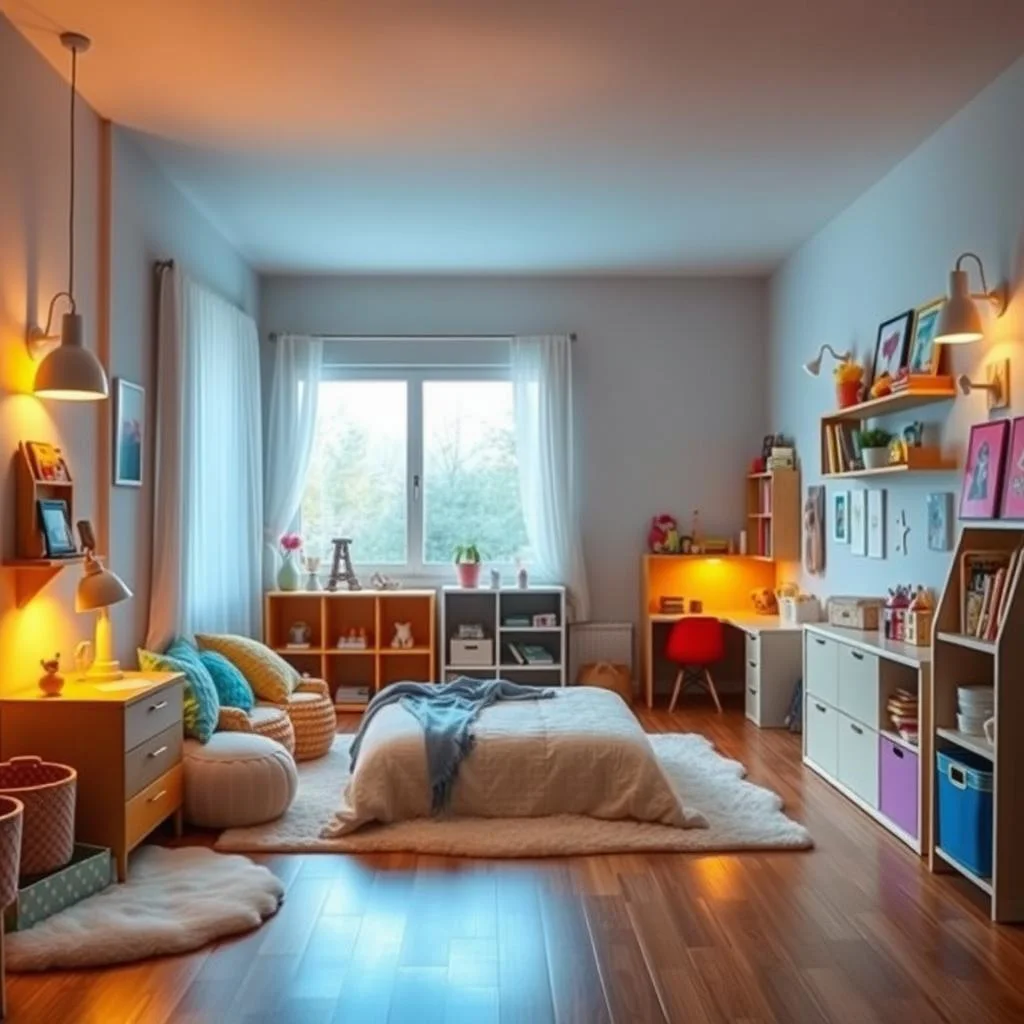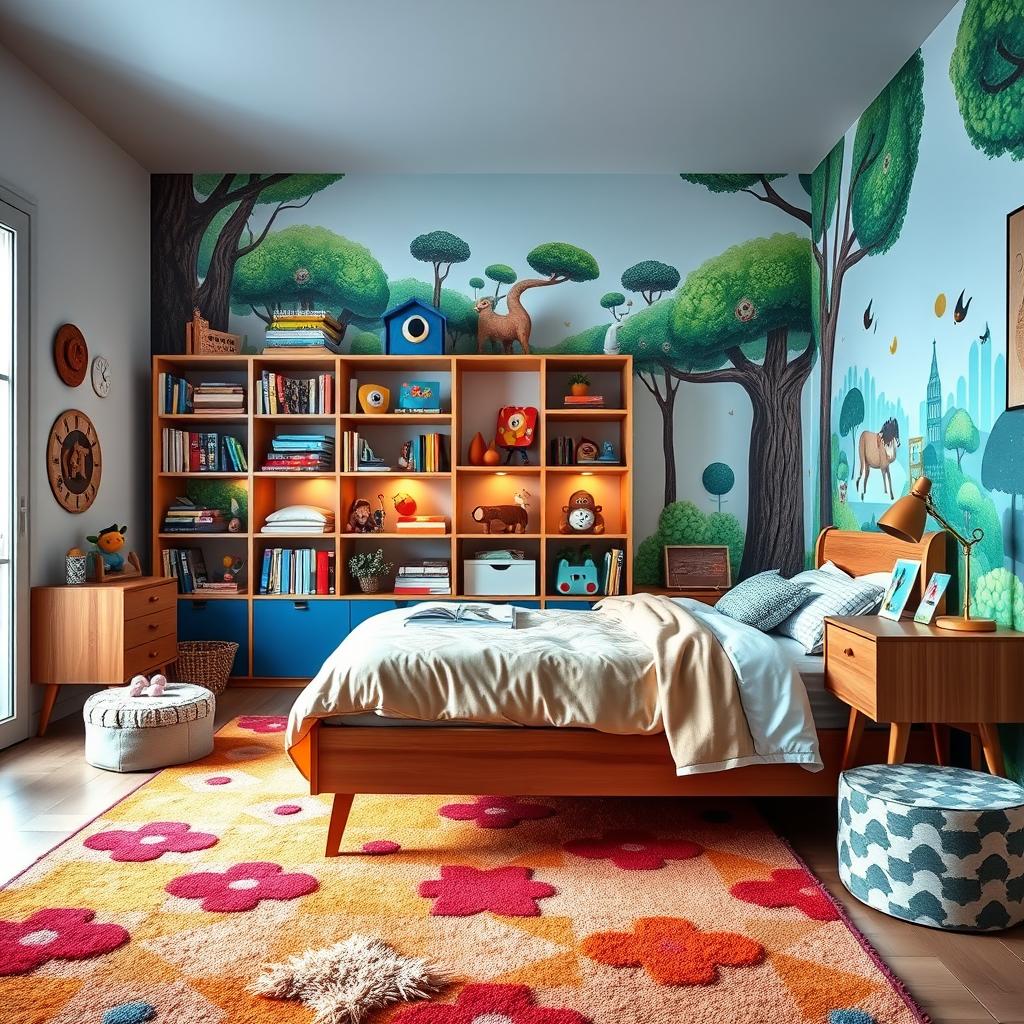Designing a kids’ room is a fun and creative journey. It lets you create a space that shows off your child’s personality. It also helps with learning, creativity, and relaxation. A well-designed room can greatly impact your child’s growth and happiness.
When it comes to playroom decor, finding the right balance is key. You want a space that’s both fun and functional. This way, your child will love spending time in it.

Introduction to Kids’ Room Design
Creating the perfect kids’ room involves thinking about safety, functionality, and personal style. By mixing elements of kids’ room design, children’s bedroom design, and playroom decor, you can make a space that’s both useful and enjoyable. In this article, we’ll share some expert ideas to help you start.
Key Takeaways
- Designing a kids’ room requires a balance of functionality and fun
- A well-designed children’s bedroom design can promote learning and development
- Playroom decor should reflect your child’s personality and interests
- Safety considerations are essential when designing a kids interior room
- Functionality and personal style should be considered when choosing kids’ room decor
- Kids’ room design should be adaptable to your child’s changing needs and interests
Essential Elements of a Kids Interior Room
Designing a kids’ room requires careful thought. It’s important to make it both functional and safe. A well-designed room can make kids feel comfortable and secure, helping them grow and develop well.
To achieve this, using kid-friendly furniture and nursery ideas is key. These should match the child’s age and needs.
A vibrant kids room can be made with colorful walls, fun decorations, and play areas. But safety must always come first. Make sure all furniture and decor are securely attached to the wall. Also, cover any sharp edges or corners.

- Age-appropriate design elements, such as furniture and decor that cater to the child’s age and interests
- Functional zones planning, which can help create a space that is both functional and efficient
- Safety considerations, such as securing heavy furniture and removing any hazardous materials
By focusing on these key elements, you can make a kids’ room that’s both fun and practical. It will be a safe and caring space for your child to grow and thrive. With the right furniture and ideas, your child’s room will be a place they’ll love for years.
Choosing the Right Color Palette for Your Child’s Space
Designing themed bedrooms for kids starts with the color palette. It sets the mood and atmosphere of the room. The right colors can boost creativity, help kids relax, and even change their mood. For creative play spaces, choose colors that spark imagination and energy.
Here are some color palettes to consider:
- Soft pastels for a calming and soothing atmosphere
- Bright primaries for a stimulating and energetic feel
- Earth tones for a natural and cozy ambiance
Choosing the right colors is about finding a balance. Mix vibrant and muted hues to create a space that’s both creative and relaxing. For instance, a themed bedroom for kids could have a bold accent wall. The rest of the room stays neutral, bringing balance and harmony.

Adding creative play spaces to the room’s design is also about color. Use color to mark areas for play, like a reading nook or art station. This encourages kids to explore and imagine. The right colors can turn a room into a fun and functional space.
Smart Storage Solutions for Toys and Belongings
When designing a kids interior room, it’s key to think about smart storage. This keeps the space tidy and clutter-free. A well-organized playroom decor helps kids feel calm and relaxed, making it easier for them to focus and play.
In a cozy kids’ room, storage can be both useful and fun. It gives kids a place to show their creativity and personality.
Some smart storage ideas include built-in shelves, baskets, and bins. Labeling each storage unit helps kids find what they need quickly. This keeps the space clutter-free. Also, multi-functional furniture, like a storage ottoman or a desk with shelves, saves space and is practical.

- Using wall-mounted shelves and hooks to keep items off the floor
- Implementing a toy rotation system to keep kids engaged and interested in different activities
- Utilizing under-bed storage containers to keep clutter out of sight
By adding these smart storage solutions to a kids interior room design, parents can make a space that’s both useful and fun. This promotes a calm and relaxed environment for their kids.
Creating Dynamic Play Areas Within the Room
A vibrant kids room needs dynamic play areas to spark imagination and creativity. Think about adding creative play spaces that encourage movement and socializing. You could set up a cozy reading nook, a building area with blocks and Legos, or a dress-up corner with costumes.
Design these play areas based on your child’s favorite activities. For example, if they love art, create a craft station with paper, markers, and paint. If they enjoy music, make a mini music zone with kid-friendly instruments.
Here are some ideas for dynamic play areas in a vibrant kids room:
- Set up a sensory bin with rice, beans, or sand and hide small toys or fun objects for your child to find.
- Create a “fort” or “hideout” using blankets, pillows, and chairs.
- Make a mini obstacle course with couch cushions and chairs.
By adding these creative play spaces, you can boost your child’s imagination and creativity. You also encourage physical activity and social interaction. Choose durable, easy-to-clean materials and always watch your child during play.

Selecting Kid-Friendly Furniture and Materials
When designing a kids’ room, picking furniture and materials that are both tough and safe is key. Kid-friendly furniture makes the space both useful and comfy. It also helps in creating a calm and relaxing area. Think about adding nursery interior ideas for cozy kids’ rooms, great for both rest and play.
A good kids’ room should have kid-friendly furniture that grows with the child. Look for furniture with adjustable parts, like beds with storage or desks that can change height. This way, the room can change as your child grows, staying comfy and safe for years.

When picking furniture and materials for a kids’ room, keep these points in mind:
- Durable materials that can handle rough play and easy cleaning
- Features that are comfy and safe, like soft cushions and smooth edges
- Furniture that can grow with the child, adjusting to their changing needs
By focusing on these points and aiming for cozy kids’ rooms, you can make a space that’s both fun and practical. Always choose kid-friendly furniture and materials that encourage relaxation, safety, and comfort. This will help your child stay happy and healthy.
Lighting Design for Different Activities
Lighting is key in designing a kids room. It sets the mood and atmosphere. A good lighting system makes a room cozy for reading, bright for play, and calm for sleep.
In a playroom, lighting can highlight special areas. For example, a reading nook or play area. This makes the room more engaging.
In themed bedrooms, lighting can bring the theme to life. A space-themed room might have lights that look like stars. It’s important to think about the room’s activities when choosing lighting.

For a kids room, mix overhead lights, table lamps, and floor lamps. This creates a warm and inviting feel. It also ensures enough light for all activities. Using dimmers or smart lights can adjust the brightness for different moods.
A well-designed lighting system is crucial for a kids room. It promotes relaxation, productivity, and creativity. Whether it’s a playroom or a themed bedroom, good lighting makes the space fun and functional.
Theme Integration and Personal Expression
Designing a kids’ room involves theme integration and personal expression. A themed bedroom sparks imagination and creativity. It makes the space special. You can add creative play spaces like a reading nook or a dress-up corner.
A cozy kids’ room is more than just a space. It’s about creating a warm atmosphere. Use soft lighting, comfy textures, and soothing colors. This makes the room both functional and fun for your child. Themes like outer space, fairy tales, and adventure can make the room unique.
Here are some ideas for theme integration and personal expression:
- Use wall decals or murals for a themed backdrop.
- Add themed bedding and curtains for color and personality.
- Decorate with themed rugs, lamps, or wall art.

By adding these elements, you can make a themed bedroom that’s both fun and useful. Involve your child in the design to make sure it reflects their personality. With creativity, you can create a cozy room for rest, play, and imagination.
Educational Elements and Learning Spaces
Designing a kids interior room should include educational elements and learning spaces. These help with cognitive development and creativity. A well-designed children’s bedroom can have a desk or reading nook to encourage a love for reading and learning. Playrooms can have activity zones for interactive play and hands-on learning.
Some ideas for educational elements and learning spaces include:
- Creating a reading nook with a comfortable seating area and a bookshelf filled with age-appropriate books
- Setting up a desk or a workspace for homework and creative projects
- Incorporating interactive play elements, such as puzzles, building blocks, or a chalkboard, into the playroom decor
By adding these elements, your kids’ room becomes both fun and useful. A well-designed children’s bedroom can help your child love learning and set them up for success in school. Consider adding a

Adding educational elements to your playroom decor can be a fun and creative activity. Involve your child in the design process and ask for their ideas. This way, you can create a space that meets their needs and interests, making learning fun and engaging.
Conclusion: Bringing Your Kids’ Room Vision to Life
As we wrap up our guide to designing the perfect kids’ room, it’s time to put your ideas into action. The goal is to find a balance between function, safety, and letting your child’s personality shine. By using the right design elements and decor, you can make a space that looks good and supports your child’s growth.
Whether you’re starting fresh or updating an existing room, keep your child’s needs and likes in mind. Let them help choose the design to make sure it reflects their personality and sparks their creativity. With careful planning, creativity, and attention to detail, you can turn your child’s room into a special place they’ll cherish for years.
FAQ
What are the essential elements to consider when designing a kids’ interior room?
When designing a kids’ room, safety is key. Choose furniture and decor that are safe and durable. It’s also important to pick items that fit your child’s age and interests.
Plan the room to make it efficient and fun. This helps your child learn and be creative.
How can I choose the right color palette for my child’s room?
The right colors can make a room feel happy or calm. Think about your child’s interests and personality when picking colors. Bright colors can spark creativity, while soft colors can help your child relax.
What are some smart storage solutions for organizing toys and belongings in a kids’ room?
Smart storage solutions include built-in shelves and cabinets. These save space and keep the room tidy. Use bins and baskets to sort toys and other items.
Choose furniture that does more than one thing. For example, a storage bed or an ottoman that also serves as a seat.
How can I create dynamic play areas within my child’s room?
To create dynamic play areas, use vibrant colors and creative spaces. Themed bedrooms can also spark your child’s imagination. These elements make the room a fun place to explore and learn.
What should I look for when selecting kid-friendly furniture and materials?
Look for furniture that’s durable, safe, and comfortable. Choose materials that can handle active play. Furniture that grows with your child is also a good idea.
Make sure the furniture is safe and comfortable. Look for rounded edges and non-toxic finishes.
How can I incorporate educational elements and learning spaces into my child’s room?
Create areas for activities like reading nooks and art stations. Use furniture and materials that are right for your child’s age. This encourages learning and exploration.
By adding these elements, you make the room a place for growth and discovery.